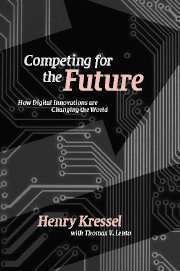Book contents
- Frontmatter
- Contents
- List of figures
- List of tables
- Acknowledgements
- Introduction
- Part I The technology – how electronic devices work – digital systems and software
- Part II Innovators, entrepreneurs, and venture capitalists
- Part III Global reach, global repercussions
- Appendix 1.1 Smaller, faster, more efficient MOSFETs
- Appendix 1.2 Building multi-transistor logic gates
- Appendix 1.3 MOSFETs in memory devices
- Appendix 1.4 CMOS reduces logic gate power dissipation
- Appendix 1.5 Laser diode basics
- Appendix 1.6 Light-emitting diodes (LEDs)
- Appendix 1.7 Photodetectors
- Appendix 1.8 Making fiber optic cables
- Appendix 1.9 Principles of LCD displays
- Appendix 2.1 The demise of analog computers
- Appendix 2.2 IP, TCP, and the Internet
- Appendix 2.3 Building an object-oriented program
- Index
Introduction
Published online by Cambridge University Press: 07 December 2009
- Frontmatter
- Contents
- List of figures
- List of tables
- Acknowledgements
- Introduction
- Part I The technology – how electronic devices work – digital systems and software
- Part II Innovators, entrepreneurs, and venture capitalists
- Part III Global reach, global repercussions
- Appendix 1.1 Smaller, faster, more efficient MOSFETs
- Appendix 1.2 Building multi-transistor logic gates
- Appendix 1.3 MOSFETs in memory devices
- Appendix 1.4 CMOS reduces logic gate power dissipation
- Appendix 1.5 Laser diode basics
- Appendix 1.6 Light-emitting diodes (LEDs)
- Appendix 1.7 Photodetectors
- Appendix 1.8 Making fiber optic cables
- Appendix 1.9 Principles of LCD displays
- Appendix 2.1 The demise of analog computers
- Appendix 2.2 IP, TCP, and the Internet
- Appendix 2.3 Building an object-oriented program
- Index
Summary
David Sarnoff, long the chairman of RCA and a pioneer in the electronics industry, summarized his career in these words: “I hitched my wagon to the electron rather than the proverbial star.”
The world has followed suit. The past sixty years have witnessed the most rapid transformation of human activity in history, with digital electronic technology as the driving force.
Nothing has been left untouched. The way people communicate, live, work, travel, and consume products and services have all changed forever. The digital revolution has spurred the rapid expansion of economic activity across the face of the planet.
In this book I will explore the unprecedented outburst of electronic innovation that created the digital revolution. Based on this example, I will examine how innovation works, what it has achieved, and what forms we can expect it to assume in the near future.
Since innovation does not happen in a vacuum, I will also explore the political and economic factors that can accelerate or impede changes in the industrial landscape. One of these is globalization, which creates neither a level playing field nor a truly “flat world.” Governments everywhere are focused on industrializing as quickly as possible in the face of growing competition. As a result, attempts to gain national competitive advantage by building artificial walls are not going away.
Defining innovation
Before outlining the issues to be covered, we must clarify what constitutes an “innovation” in the first place.
- Type
- Chapter
- Information
- Competing for the FutureHow Digital Innovations are Changing the World, pp. 1 - 6Publisher: Cambridge University PressPrint publication year: 2007



